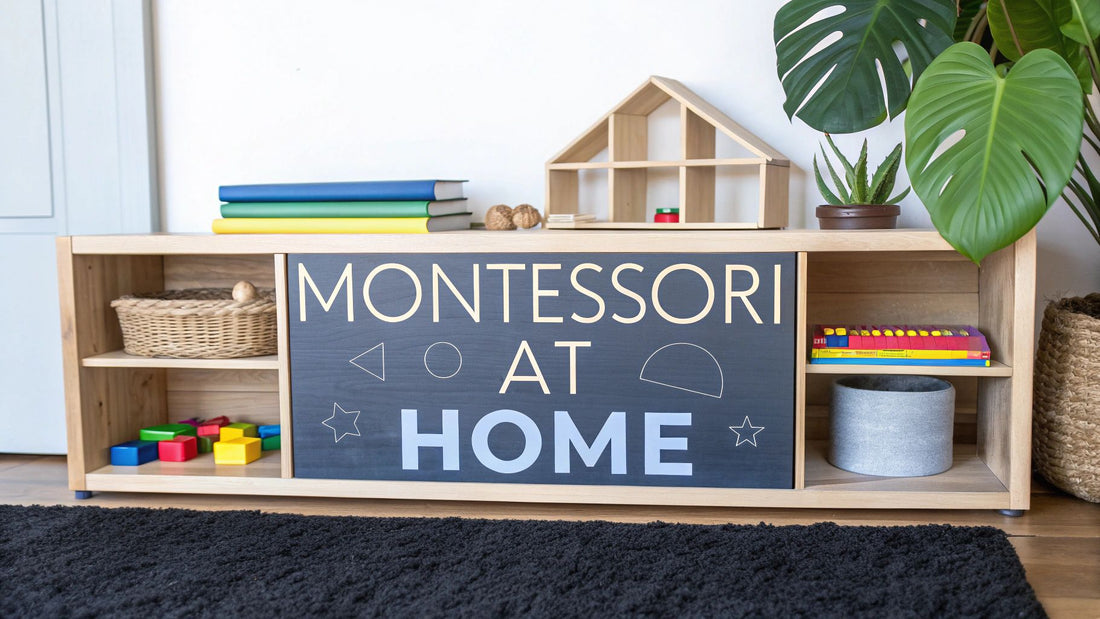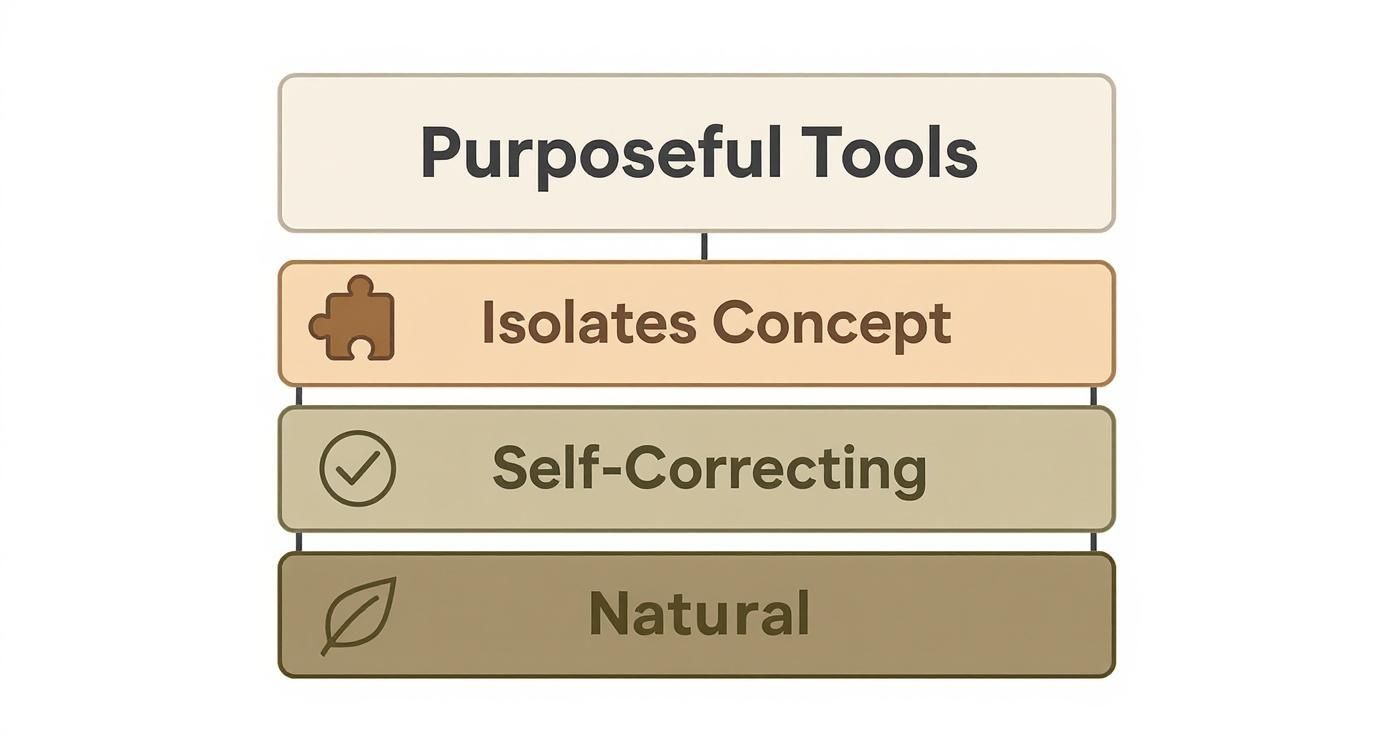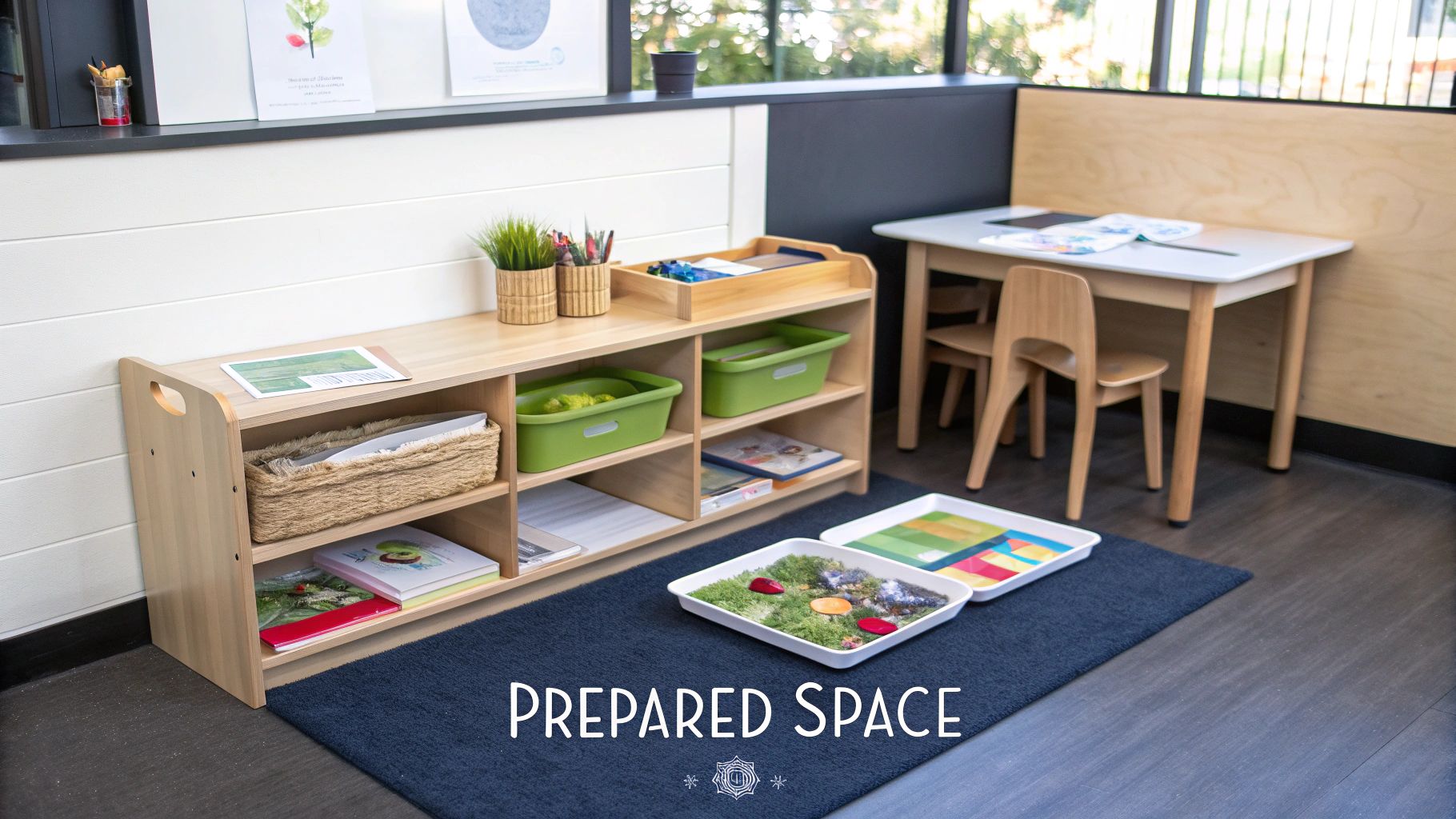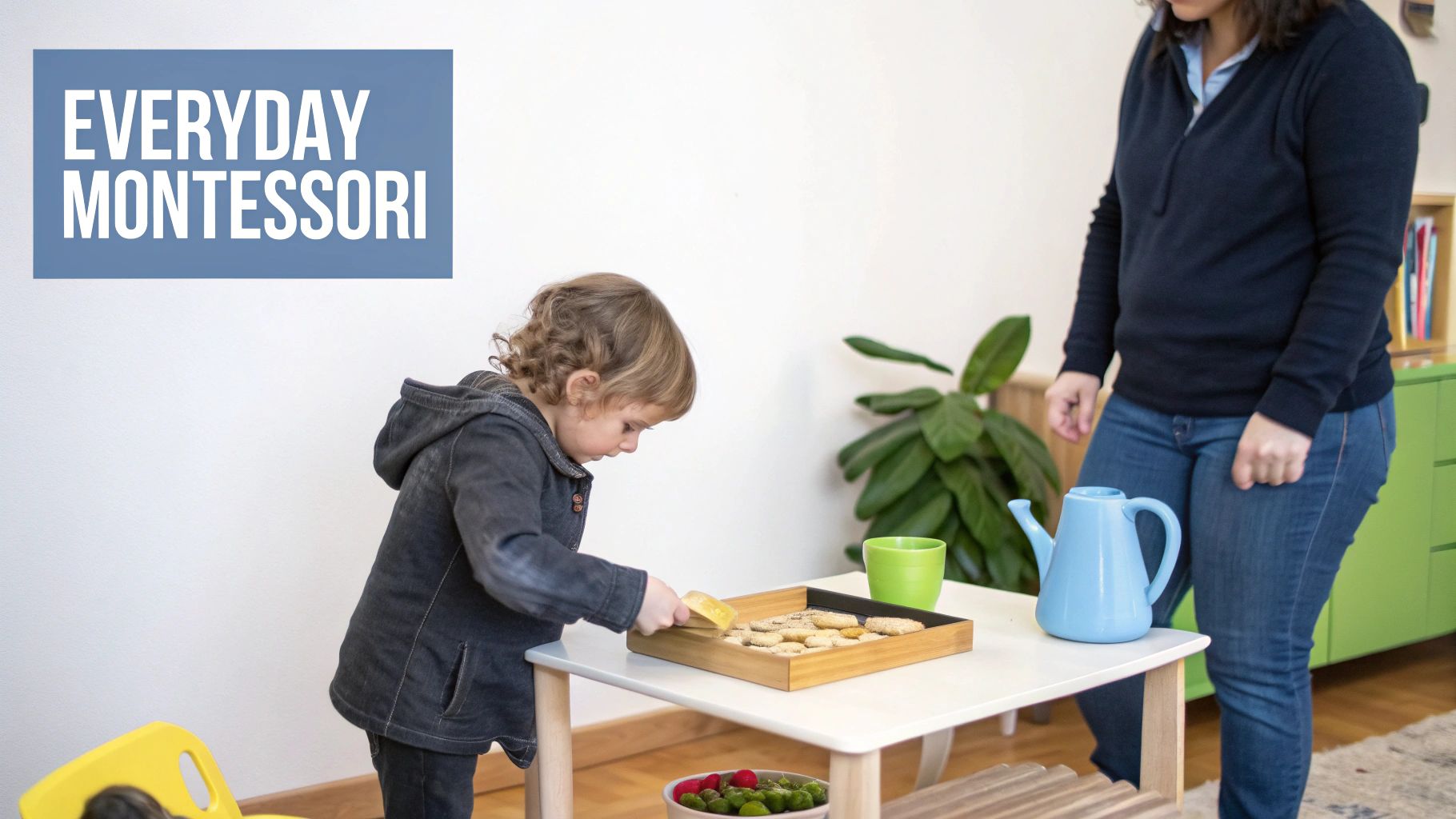
Your Guide to Montessori Materials for Home
Share
When you hear "Montessori," what comes to mind? For many, it's those beautifully crafted wooden materials. But these aren't just toys; they're purposeful, hands-on tools designed for independent learning. Think of them as a perfectly curated toolkit where every single item has a specific job to do, helping a child build their understanding of the world one step at a time.
What Are Montessori Materials for Home
Montessori materials essentially turn your home into a landscape of discovery. They look very different from the bright, noisy plastic toys you see everywhere else, and that's completely by design.
Each material is carefully crafted to help a child explore one specific concept, whether it's learning to pour water without spilling or truly understanding what the number "3" means. This approach shifts the dynamic, empowering children to become active drivers of their own education, not just passive passengers.
The whole philosophy is built on respecting a child's natural development. This is why you’ll almost always find these materials made from natural things like wood, metal, and glass. The weight of a wooden block or the coolness of a metal knob provides rich sensory feedback that plastic simply can't match.
Core Principles of the Materials
To be truly effective, authentic Montessori materials follow a few key principles. Once you get these, you’ll be able to spot the real deal from a mile away.
- Isolation of a Concept: Each material is designed to teach one single skill or idea. For example, the famous Pink Tower is a set of ten pink cubes. They are all the same color and texture; the only thing that changes is their size. This lets the child focus completely on the concept of dimension without being distracted by different colors or patterns.
- Self-Correction: This is the secret sauce. The materials have a built-in "control of error." If a child stacks the Pink Tower out of order, it will look wobbly and might even fall over. This immediate, concrete feedback lets them see and fix their own mistakes without an adult having to say, "That's wrong." It’s a huge confidence booster and builds real problem-solving skills.
More and more parents are catching on to this idea of purposeful play. In fact, the global market for Montessori toys is projected to reach $10 billion by 2029—a massive jump. This shows a real shift in thinking, as families are choosing hands-on, developmental tools over passive entertainment. If you want to dive deeper into this, you can read more about what it looks like to bring Montessori education at home.
Montessori Materials vs Traditional Toys at a Glance
It can be tough to see the difference between a Montessori material and a high-quality "educational" toy at first glance. This little table breaks down the key distinctions.
| Characteristic | Montessori Materials | Traditional Toys |
|---|---|---|
| Primary Purpose | To support independent learning and skill development. | Primarily for entertainment and amusement. |
| Design Focus | Simple, purposeful, and focused on a single concept. | Often complex, with lights, sounds, and multiple functions. |
| Material | Typically natural materials like wood, metal, and fabric. | Mostly plastic and synthetic materials. |
| Child's Role | Active participant; the child learns through doing. | Often a passive observer or recipient of entertainment. |
Ultimately, the goal of a Montessori material is to empower the child to do something, while many traditional toys are designed to do something for the child. It's a small but powerful difference.
Exploring the Core Categories of Materials
Think about building a house for a moment. You wouldn't just throw up the walls and slap on a roof, right? You need a solid, reliable foundation first. In the world of Montessori materials for home, the core categories work the same way. Each one builds on the last, creating a complete structure for learning.
Understanding these categories gives you a clear roadmap. It helps you see why certain activities come before others and how they all weave together to support your child’s growth. This isn't about randomly buying educational toys; it's about curating a thoughtful, progressive learning path.
This infographic lays out the core principles that make these materials such powerful tools for learning.

As you can see, every single material is designed to be self-correcting, focus on one specific concept, and feel good in a child's hands. It's all about purposeful design.
Practical Life and Sensorial: The Foundation
The journey always begins with two foundational categories: Practical Life and Sensorial. These are the concrete slab and framework of our learning house, getting your child ready for everything that comes next.
Practical Life materials are often the most familiar and easiest to start with. They are all about the everyday tasks that help children master real-world skills, build their concentration, and fine-tune their motor control.
- Pouring Activities: Using small pitchers to pour water or dry goods like rice from one cup to another.
- Dressing Frames: Boards with buttons, zippers, and laces that let a child practice getting dressed all by themselves.
- Spooning and Tonging: Moving small objects from one bowl to another with different tools.
These activities are so satisfying for a young child who is desperate for independence and a sense of purpose.
Next up, Sensorial materials are designed to sharpen the five senses. Dr. Montessori knew children learn by exploring the world through their senses, and these materials help them organize all that incoming information. It’s like giving them a high-definition lens to see the world through.
The real goal of Sensorial work isn't to teach new facts. It's to help a child make sense of the information they're already taking in. It brings a sense of order to their understanding of the world.
Great examples include the Pink Tower, which isolates the concept of size, or the Sound Cylinders, which train the ear to tell the difference between volumes. This refinement of the senses is what prepares the mind for more abstract subjects down the road.
Language and Mathematics: The Structure
With a strong foundation poured and framed, we can now start building the walls and roof with Language and Mathematics. All the skills developed through Practical Life and Sensorial work directly feed into this next level of learning. The pincer grasp a child perfects with a knobbed puzzle is the very same one they'll need to hold a pencil.
Language materials make abstract concepts like reading and writing totally tangible. Children don’t start with a pen and paper; they start by feeling and seeing.
- Sandpaper Letters: A child traces the shape of a letter with their fingers, creating a muscle memory connection to the symbol.
- Movable Alphabet: This box of wooden letters lets children build words and express their thoughts long before their hands are steady enough to write them perfectly.
Finally, Mathematics materials turn numbers from abstract ideas into concrete objects a child can actually hold. This hands-on approach builds a deep, physical understanding of quantity and how numbers work. A child who uses the Golden Beads doesn't just learn that "1000" is a big number; they feel the weight and see the size of a thousand-bead cube, making the concept real and unforgettable.
How to Choose the Right Materials for Your Child
Walking into the world of Montessori materials for home can feel a bit like being a kid in a candy store. Everything looks beautiful, intriguing, and oh-so-educational. It's easy to get carried away.
But the real secret isn't about buying all the popular stuff. It's about shifting your focus from the shelf to your own child. What are they really trying to figure out right now? Are they endlessly stacking blocks, meticulously lining up toys, or trying to fit small objects into bigger ones?
Let that natural curiosity be your roadmap. A single, well-chosen material that speaks directly to their current fascination is worth more than a dozen expensive items they just aren’t ready for yet.
The Litmus Test for a Great Material
So, when you’re eyeing a new material, how do you know if it's the right fit? I like to run it through a quick mental checklist. This little process helps you cut through the noise and make sure your choices are truly purposeful. A great Montessori-aligned material really needs to check three boxes.
-
Isolates a Single Skill: The material should be brilliantly simple, free from distracting bells and whistles. Think of a shape puzzle where all the pieces are the same color. The goal is to focus purely on matching the form, not getting sidetracked by matching colors.
-
Allows for Self-Correction: Can your child figure out if they got it right without you telling them? That's the magic. A puzzle piece that only fits in its correct slot is a perfect example of this built-in "control of error." It empowers them to learn from their own exploration.
-
Promotes Independent Work: The best materials are almost magnetic. They invite a child to engage and allow them to see a challenge through from start to finish, all on their own.
This kind of purposeful design is why more and more families are bringing these tools home. In fact, the global market for Montessori materials hit about USD 1.73 billion in 2024, showing a huge shift toward sustainable, child-led learning. You can dig into more of the data on the growth of Montessori materials for home use.
Finding the Right Materials for Your Child's Age
Choosing the right material is all about timing. A tool that's perfect for a 3-year-old might be frustrating for a 1-year-old or boring for a 5-year-old. To make it a little easier, here’s a quick-reference guide to help you match materials to your child's developmental stage.
Age-Based Guide to Selecting Montessori Materials
| Age Range | Key Developmental Focus | Example Materials |
|---|---|---|
| 0-12 Months | Sensory exploration, gross motor skills, hand-eye coordination. | Mobiles, grasping beads, object permanence box, soft blocks, simple puzzles with large knobs. |
| 1-2 Years | Fine motor refinement, language explosion, problem-solving. | Posting toys, ring stackers, shape sorters, first puzzles, matching cards with real images. |
| 2-3 Years | Practical life skills, early math concepts, order and sequence. | Pouring activities, dressing frames, cylinder blocks, Pink Tower, Brown Stair, color tablets. |
| 3-6 Years | Abstract concepts, literacy and numeracy, complex problem-solving. | Sandpaper Letters, Moveable Alphabet, Number Rods, Golden Beads, botany puzzles, maps. |
Remember, these are just guidelines! The most important thing is to observe your child. Their interests and readiness are always the best indicators of what they need next on their learning journey.
Balancing Authenticity and Affordability
This is a question I hear all the time: "Do I have to buy the expensive, 'authentic' materials?" And the short answer is no. While the traditionally crafted wooden materials are undeniably beautiful and built to last, it’s the principles behind them that hold the real power.
Remember, Montessori is a philosophy, not a product line. You can honor the principles of purposeful, hands-on learning without exclusively buying from high-end brands.
A DIY posting activity you make with an old spice jar and some Q-tips can teach the exact same pincer grasp and coordination skills as a pricey store-bought version.
The goal is to provide tools that empower your child's natural drive to learn. Whether that’s a classic wooden Pink Tower or a carefully selected set of nesting bowls from your own kitchen, what matters is that the item serves a clear developmental purpose. This flexibility is what makes bringing Montessori home so accessible and personal.
Creating a Prepared Learning Space at Home

Once you've picked out a few key montessori materials for home, the next big step is creating a space that actually invites your child to use them. This is what Dr. Montessori famously called the “prepared environment”—a space where everything is intentionally arranged to spark independence, focus, and a genuine love for learning.
Think of it like a professional chef's kitchen. Every tool has its place, the ingredients are within arm's reach, and the whole layout is designed for creativity and flow. For your child, this means a space that is orderly, accessible, and calm. It’s a place where they can truly sink into their "work."
Don't worry, this doesn't mean you need a full-blown classroom makeover. It's really about applying a few simple principles to a corner of a room, creating a 'yes' space where your child feels capable and respected.
The Power of Low Open Shelving
The absolute cornerstone of any Montessori space is a low, open shelf. Unlike a toy box where things get jumbled and forgotten, a shelf lets you display a small, curated selection of materials beautifully. This simple change sends a powerful message to your child: “This is your space, and these are your tools for learning.”
When a young child can clearly see their options laid out, it's a natural invitation to explore. It empowers them to make their own choices, take out an activity, and—just as crucial—put it back where it belongs when they're done.
A prepared environment should be a place of beauty and order. It is not a place for 'things,' but a place for the development of the child.
This external order helps build a child's internal sense of order, cutting down on overwhelm and stretching their ability to concentrate.
Organizing Activities with Trays and Baskets
Presenting each material on its own tray or in a small basket is a total game-changer. This simple trick creates clear visual boundaries for an activity, helping a child intuitively understand that all the pieces belong together. It makes the work feel self-contained and much more manageable.
A tray also makes it easy for a child to carry their chosen work to a mat or a table, which reinforces the entire cycle of selecting, completing, and returning an activity. Of course, having a comfortable, child-sized workspace is key; you can check out our guide on choosing a Montessori table and chair set to complete the environment.
The Art of Material Rotation
Finally, to keep the space feeling fresh and engaging, you’ll want to rotate the materials on the shelf. This doesn't mean you have to constantly buy new things! It’s all about observing your child and swapping activities based on their current interests and developmental stage.
Just follow these simple guidelines for rotation:
- Observe First: Take note of which materials are being ignored or which ones your child has totally mastered. These are your top candidates to be swapped out.
- Keep it Limited: Aim for just 6-8 activities on the shelf at any given time. This offers choice without creating decision fatigue.
- Introduce New Materials: When you bring out something new, give your child a slow, deliberate demonstration of how to use it. Then, step back and let them explore on their own terms.
This thoughtful rotation keeps the space exciting and ensures the available montessori materials for home are always perfectly matched to your child's learning journey.
Applying Montessori Principles Beyond Materials

While those beautifully crafted wooden materials are what most people picture when they hear "Montessori," the real magic happens when you see it as a way of life, not just a collection of items. The principles behind montessori materials for home are meant to be woven right into your daily routines, turning ordinary moments into powerful learning opportunities.
Think of the materials as a training ground. The skills a child hones on their activity shelf—like carefully pouring water between two small pitchers—are direct practice for real-world tasks. This is where learning truly comes alive and sticks.
When you invite your child to take part in meaningful family jobs, you're showing them they are a capable and valued member of the household. This builds a deep sense of confidence and belonging that no single toy could ever offer on its own.
Integrating Learning into Daily Life
The bridge from shelf work to real life is built with simple, practical activities. It requires a small shift in perspective: instead of seeing chores as things to be done for your child, see them as chances to do things with your child. This change is everything.
- In the Kitchen: Let your little one help prepare a simple snack. They can wash fruits, tear lettuce for a salad, or spread butter on toast.
- Caring for the Home: A small cloth for dusting low surfaces or a child-sized broom for sweeping crumbs after a meal makes them an active participant.
- Nurturing Nature: Give them the responsibility of watering a sturdy little houseplant.
These purposeful tasks are the heart of the philosophy. You can find many more inspiring Montessori practical life activities that blend learning seamlessly with your family’s rhythm.
The greatest sign of success for a teacher... is to be able to say, 'The children are now working as if I did not exist.' This principle applies just as much to a parent at home, fostering a spirit of joyful independence.
Fostering Concentration and Respect
Applying Montessori principles goes beyond physical tasks; it’s also about honoring your child’s focus and communicating with respect. When your child is completely absorbed in an activity—whether it's stacking blocks or watching an ant crawl across the sidewalk—try to protect that bubble of concentration. This uninterrupted focus is where deep learning takes root.
The Montessori approach also has a profound influence on a child's emotional and social growth. You can explore more strategies for teaching children emotional intelligence to see how this holistic view extends to all areas of development. It’s no wonder this approach is gaining traction. As more families look for personalized education, the global homeschooling market is expected to hit USD 8.95 billion by 2032, driving demand for effective at-home educational philosophies.
Common Montessori Myths Debunked
Diving into the world of Montessori materials for home is exciting, but it often comes with a few stubborn myths. These ideas can make the whole approach feel complicated or out of reach for most families. Let's clear the air and tackle some of the biggest misunderstandings right now.
The first hurdle for many parents is the perceived cost. There's a common belief that you have to shell out a small fortune for high-end, brand-name materials to "do Montessori" the right way. That’s just not true.
The real value is in the philosophy, not the price tag. An empty spice jar and a handful of Q-tips can teach fine motor skills just as effectively as an expensive posting toy.
It's all about understanding the purpose behind a material. You can almost always find affordable alternatives—or even make your own DIY versions—that hit the exact same developmental goals. This makes the Montessori way completely doable on any budget.
It Is Not Unstructured Chaos
Another big myth? That a Montessori home is a free-for-all where kids run wild. The opposite is actually true. While children get a lot of freedom, it’s always freedom within clear, respectful limits.
The structure isn't coming from an adult hovering over their shoulder. Instead, it’s baked right into the prepared environment and the materials themselves. Think of it this way:
- Orderly Shelves: Activities are presented neatly on low shelves, but there aren't too many of them out at once. This creates a calm atmosphere that naturally encourages focus.
- Defined Workspaces: Using a simple tray or a small mat for each activity gives the child a clear, contained space for their work. It’s their zone.
- Self-Correcting Materials: The materials are cleverly designed to guide the child. If a piece doesn't fit, they know to try again. This provides gentle, built-in structure without an adult having to say a word.
This approach helps a child build independence and self-discipline from the inside out, rather than just waiting for external direction. It’s proof that a peaceful, child-led space can also be an incredibly effective and structured one.
Your Montessori at Home Questions Answered
Diving into the world of Montessori materials for home is exciting, but it naturally brings up a few practical questions. Let's walk through some of the most common ones to help you feel confident as you get started.
How Many Materials Should I Put on the Shelf?
This is a question I hear all the time. While there's no single magic number, a great place to start is with six to eight activities available on an open, low shelf.
This amount offers enough variety to spark your child's interest without overwhelming them with too many choices. The goal is to encourage them to choose an activity with real intention and see it through.
What if My Child Uses a Material "Wrong"?
It’s completely normal—and expected—for a child to explore a material in a way you didn't anticipate. Before you step in to correct them, just pause and watch for a moment. Are they being destructive, or are they just discovering a new quality of the object on their own terms?
The whole idea is to follow the child. As long as they are being respectful of the material and are focused, it's usually best to let that exploration happen.
If they are genuinely missing the main point of the activity, you can always offer a gentle re-introduction later on. A simple, "I'd love to show you another way to use this," while you demonstrate its purpose again, works wonders without any criticism.
Can I Mix Montessori Materials with Our Other Toys?
Absolutely! A Montessori-inspired home doesn't mean you have to get rid of every single traditional toy. It's all about finding a good balance and keeping things organized. Keep your purposeful Montessori materials for home neatly presented on trays on their dedicated low shelf.
You can store other toys, like LEGOs, dolls, or dress-up clothes, in separate baskets or bins. This creates a clear distinction and helps your child understand that different items have different purposes—some are for focused skill-building, and others are for wide-open imaginative play.
At Ocodile, we believe in creating spaces that help your child grow and become more independent. Take a look at our collection of child-friendly furniture, designed to perfectly complete your prepared environment at https://ocodile.com.








